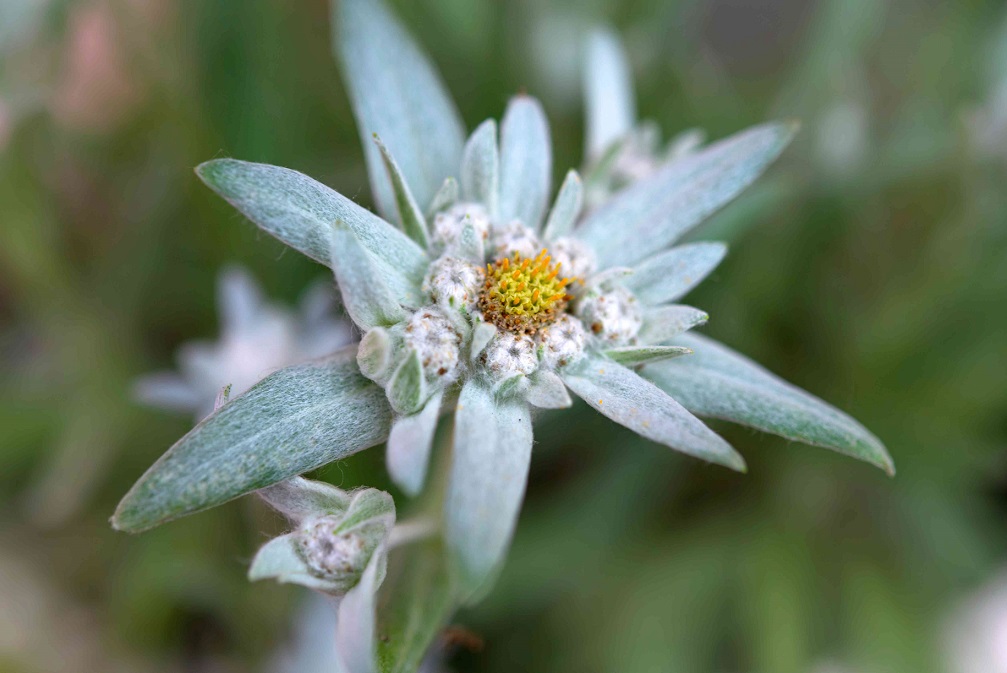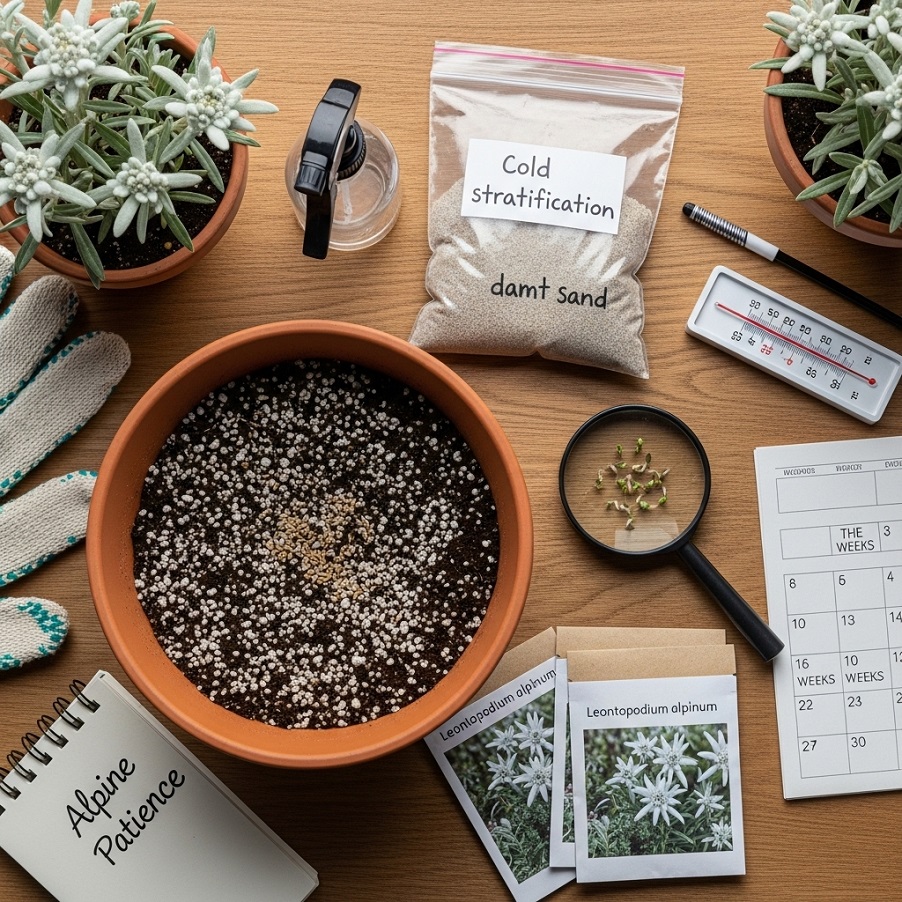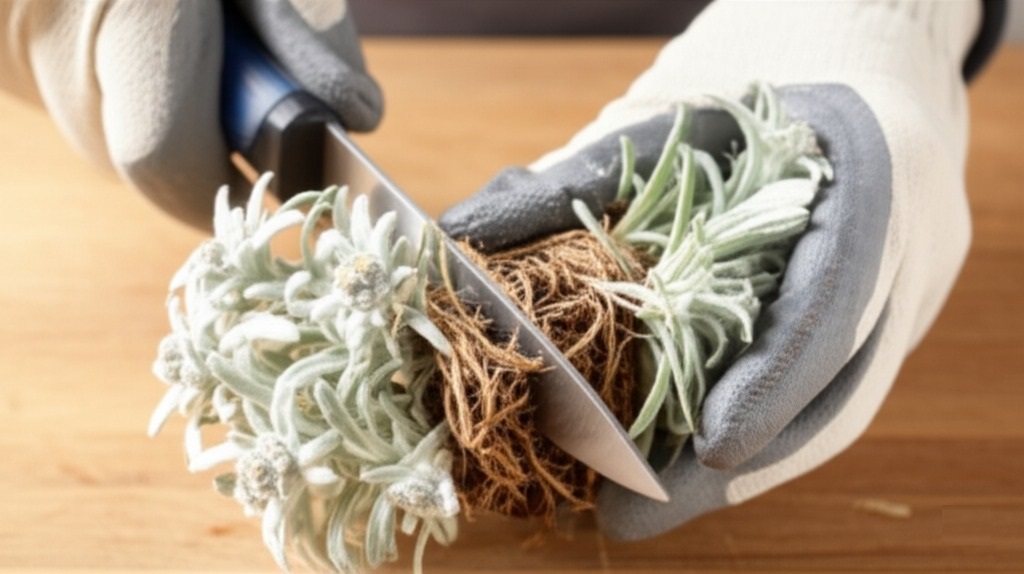I’ll never forget the moment I first spotted an edelweiss flower during a hiking trip in the Swiss Alps three summers ago.
After hours of climbing through rocky terrain at nearly 8,000 feet, there it was—a small, star-shaped cluster of fuzzy white blooms clinging to a limestone cliff. It looked nothing like the pristine, almost magical flower I’d imagined from “The Sound of Music.” In fact, my first thought was, “That’s it? That’s what all the fuss is about?”
But here’s the thing about edelweiss (Leontopodium nivale)—its true beauty isn’t just in its appearance. It’s in the incredible story of survival, the cultural legends it has inspired, and yes, the surprising fact that you can actually grow this alpine legend in your own garden.
If you’ve ever been curious about this iconic mountain flower, wondered about its deep symbolism, or dreamed of adding a piece of the Alps to your backyard, you’re in for a treat.
Related posts: How to Grow Epipremnum amplissimum with Complete Care Guide to This Silver Beauty
What Makes Edelweiss Truly Special
The Science Behind the Star
Edelweiss isn’t technically a single flower—it’s actually a clever botanical illusion. What looks like star-shaped white petals are specialized leaves called bracts that surround clusters of 50 to 500 tiny yellow flowers grouped into 2 to 12 flower heads.
These white “petals” are covered in dense, woolly hairs that serve as the plant’s secret weapon against the harsh alpine environment.
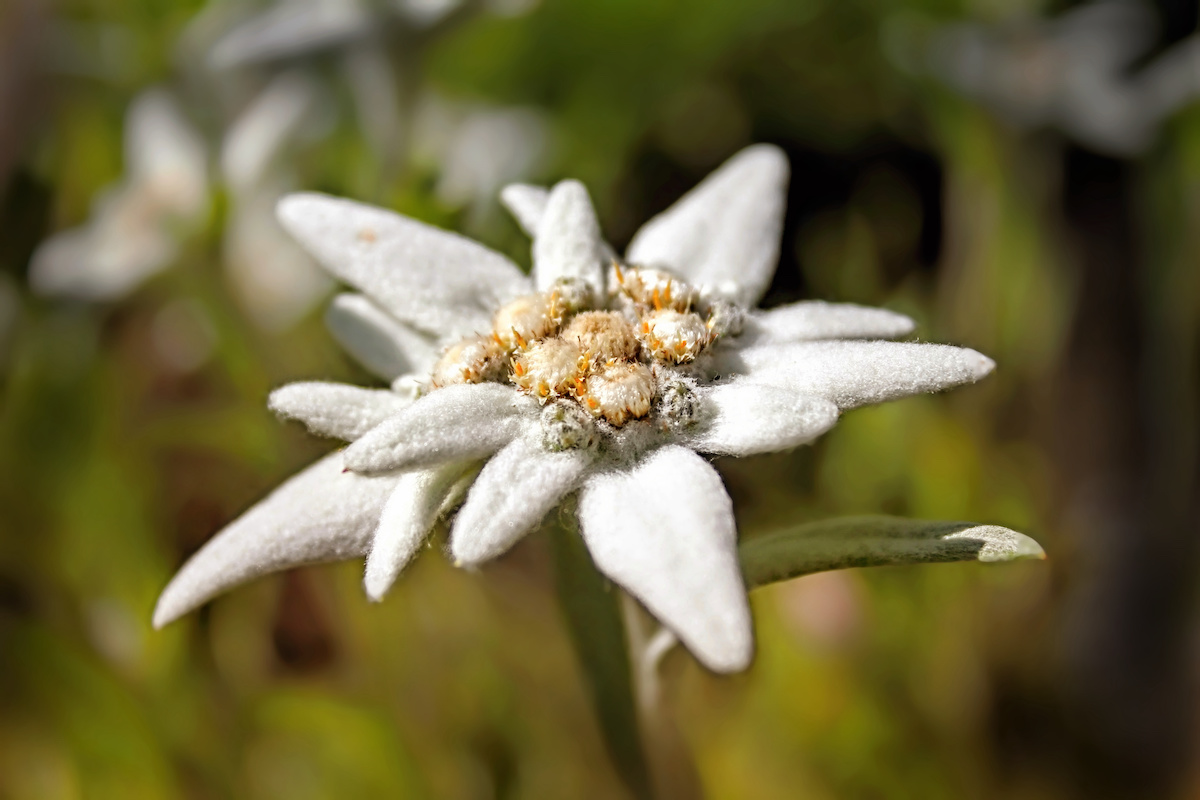
Think of these fuzzy hairs as nature’s equivalent of a high-tech outdoor jacket. They protect the plant from freezing temperatures (down to -23°F), intense UV radiation at high altitudes, strong mountain winds, and rapid moisture loss.
The result? A plant that can thrive where few others dare to grow, typically between 5,900 and 11,200 feet elevation on rocky limestone cliffs and alpine meadows across the Alps, Pyrenees, Carpathians, and even extending into parts of Asia where it originally evolved.
A Flower by Many Names
The word “edelweiss” comes from German, combining “edel” (noble) and “weiß” (white)—quite literally meaning “noble white.” But this flower goes by many charming names across its range:
- French/Italian: “Étoile des Alpes” or “Stella Alpina” (Star of the Alps)
- Romanian: “Floare de colț” (Cliff flower)
- Slovenian: “Planika” (Mountain girl)
- Historic German: “Wullbluomen” (Wool flower)
- Scientific: Leontopodium nivale (Lion’s paw)
Each name tells part of the story—its star-like appearance, its cliff-dwelling nature, its fuzzy texture, and its noble character.
The Rich Tapestry of Edelweiss History and Culture
Love, Legend, and Life-Threatening Climbs
The romantic legend of edelweiss is both beautiful and tragic. According to Alpine folklore, young men would risk their lives climbing treacherous mountain faces to gather these rare flowers for their beloved. The gift of an edelweiss bloom was considered the ultimate proof of love and courage—a promise of dedication that could cost a man his life.
One particularly poignant legend tells of a young man who fell to his death while collecting edelweiss for his love, a girl named Edelweiss. Heartbroken, she wandered the mountains calling his name until she too perished in the snow. From that day forward, the flower bore her name as a symbol of eternal love and sacrifice.
Here’s a fascinating reality check from my research: edelweiss isn’t actually as rare or inaccessible as 19th-century literature made it seem. Many grow in relatively accessible alpine meadows just a gentle walk from mountain paths.
The myth of extreme rarity was partly perpetuated by early mountaineers who wanted to enhance their own reputations for bravery! German author Berthold Auerbach’s 1861 novel “Edelweiss” dramatically exaggerated the danger, claiming that “possession of one is proof of unusual daring.”
From Royal Romance to Cultural Icon
The flower gained widespread fame in 1856 when Austrian Emperor Franz Joseph I picked an edelweiss for his wife Elisabeth during a mountain hike, declaring it “the first in my life that I picked myself.”
This royal endorsement launched edelweiss into the spotlight, and Empress Elisabeth even wore elaborate diamond edelweiss jewelry designed by court jeweler Alexander Emanuel Köchert.
The plant quickly became a symbol of the Austro-Hungarian Army’s alpine divisions, and its star-shaped form appeared on military insignia. During World War II, edelweiss took on complex meanings—it was both Adolf Hitler’s favorite flower and the secret symbol of the anti-Nazi resistance group called the Edelweiss Pirates.
Today, it remains Austria’s national flower and a beloved symbol of Alpine culture, featured on everything from military badges to beer labels.
Here’s How to Plant And Care for Snowdrops – A Gardener’s Guide
Understanding Edelweiss Varieties and Growing Realities
Popular Cultivars for Home Gardens
While wild edelweiss is protected throughout most of its native range, several cultivated varieties are available for home gardeners:
Leontopodium alpinum varieties:
- ‘Matterhorn’: Compact, heavily branched form with classic appearance
- ‘Mont Blanc’: Early-flowering variety known for larger blooms
- ‘Blossom of Snow’: Impressive variety reaching 16 inches tall with up to 30 flowers per plant
Leontopodium souliei (Chinese dwarf edelweiss):
- ‘Alpine White’: Compact 8-inch variety perfect for containers
- ‘Mignon’: Tiny 4-inch variety that forms dense, flower-covered mats
The Bloom Cycle: What to Expect and When
Edelweiss flowers bloom from late spring through early fall, with peak flowering typically occurring between June and August. In ideal conditions, you might see blooms as early as May and as late as September. Individual flowers don’t last long, but the plants bloom intermittently throughout the season.
The flowers themselves have a subtle beauty—fuzzy white star-shaped bracts surrounding small yellow centers, with a gentle sweet fragrance reminiscent of honey or hyacinth. As the season progresses, the “stars” become less defined as the central flower heads develop, giving the plant a fuller but less sculptural appearance.
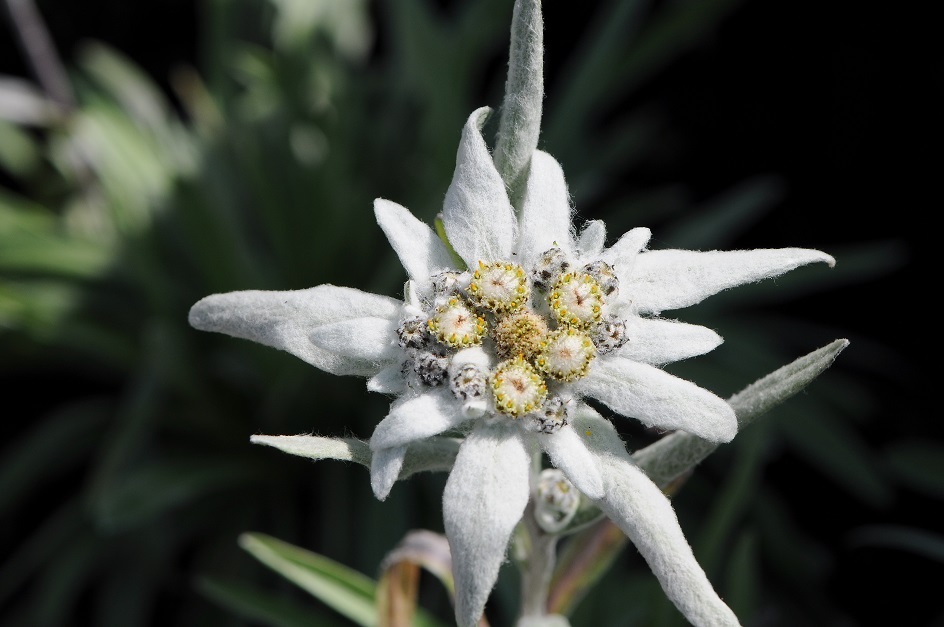
Growing Edelweiss: Bringing the Alps Home
The Container Advantage
Let me share something that took me two failed attempts to learn: for most gardeners, containers are actually the better choice for growing edelweiss. This approach gives you complete control over soil conditions, drainage, and winter protection. I now grow all my edelweiss in large terracotta pots that I can move seasonally.
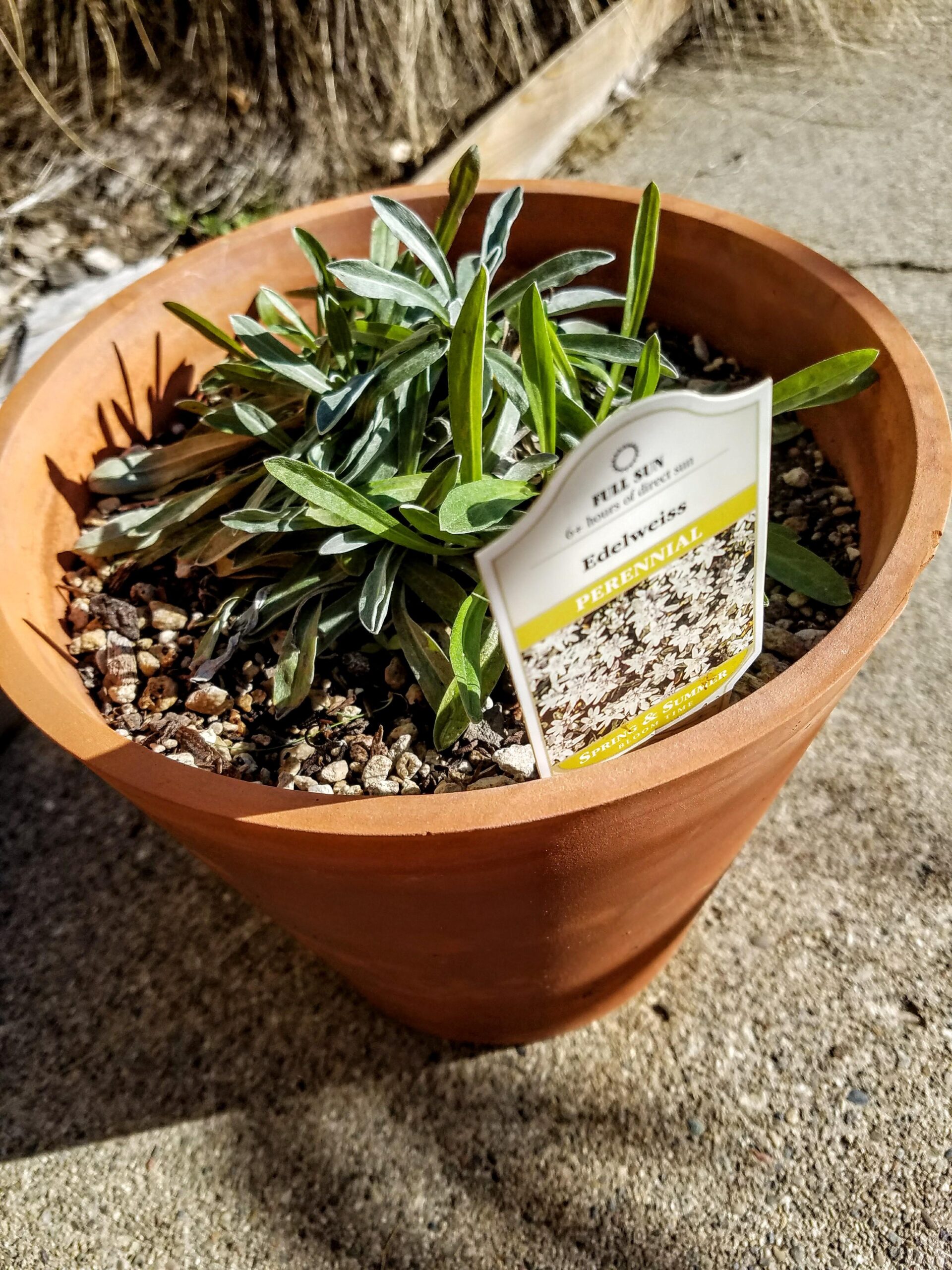
Container Setup for Success:
Choose pots at least 12 inches wide with multiple drainage holes. Fill the bottom quarter with coarse gravel or broken pottery for drainage, then use a custom soil mix of equal parts quality potting soil and coarse sand, with added grit and a handful of crushed limestone. The goal is soil that drains so fast you can practically watch the water disappear.
Location and Climate Considerations
Edelweiss thrives in USDA zones 4-7 but struggles anywhere hot and humid. Choose a spot that gets full morning sun but some afternoon shade in warmer climates. I’ve found that east-facing locations work beautifully—the plants get the bright light they crave without the stress of all-day summer heat.
In challenging climates, treat edelweiss like alpine treasures. Use containers that can be moved to cooler spots during heat waves, ensure excellent air circulation, and consider growing them in an unheated greenhouse or cold frame where you can control conditions more precisely.
Starting Your Edelweiss Journey
- From Seed: The Patient Gardener’s Path
Growing edelweiss from seed requires what I call “alpine patience.” Here’s my tried-and-true method:
Start with cold stratification—mix seeds with slightly damp sand in a plastic bag and refrigerate for 3-4 weeks. Surface sow on your prepared soil mix (never bury edelweiss seeds as they need light to germinate), keep at 60-65°F, and mist regularly. Expect germination anywhere from 2-6 weeks, and don’t panic if it takes longer.
The real test of patience comes after germination. Edelweiss seedlings grow incredibly slowly, often appearing to do nothing for months while they build strong root systems. Most won’t bloom until their second year, and some take even longer to reach flowering size.
- Division: The Reliable Route
If you can source mature plants, division is much more reliable and faster. Every 3-4 years in spring, carefully dig up established clumps and separate them into sections with both healthy roots and shoots.
I use a sharp, clean knife to cut through the root system, ensuring each division has at least two growing points. This method typically gives you blooming plants within a year.
Here’s How to Propagate Plants in Water: Easy Step-by-Step Method
Essential Care Guidelines
Mastering the Watering Balance
Edelweiss watering follows what I call the “Goldilocks principle”—not too much, not too little, but just right. During the first year, I water when the top inch of soil feels dry. After establishment, they’re remarkably drought-tolerant and actually prefer occasional stress over constant moisture.
The biggest killer of cultivated edelweiss is crown rot from overwatering. Water early in the day so plants can dry before evening, and always err on the side of too little rather than too much. In my experience, an edelweiss that looks slightly stressed from dryness will recover beautifully, but one with soggy roots rarely survives.
The Nutrient-Poor Philosophy
One of my biggest early mistakes was trying to “help” my edelweiss with rich fertilizer. These plants evolved in nutrient-poor alpine soils and actually perform worse with heavy feeding. I now fertilize very sparingly—maybe once in early spring with a heavily diluted, low-nitrogen fertilizer, if at all.
The plants prefer slightly alkaline soil (pH 6.5-7.5), so I work a small amount of lime into the soil every 2-3 years. However, I always test the pH first, as too much lime can be just as problematic as too little.
Seasonal Care and Winter Protection
- Spring: Remove any winter protection gradually, divide overcrowded clumps, and apply minimal fertilizer if desired. This is also the best time for transplanting.
- Summer: Focus on proper watering and watch for signs of heat stress. In hot climates, provide afternoon shade and ensure excellent air circulation.
- Fall: Allow plants to go dormant naturally. You can collect seeds if you want to try propagation, or deadhead spent flowers to prevent self-seeding.
- Winter: Here’s the crucial point most guides miss—edelweiss doesn’t need protection from cold, it needs protection from wet. In areas with wet winters, I cover my container plants with a clear plastic shelter that blocks rain but allows air circulation. Garden plants benefit from a layer of gravel mulch to improve drainage around the crown.
For container plants in very cold areas, wrap pots in bubble wrap or burlap and place them on wooden blocks to prevent freezing from the bottom. But never bring them indoors—they need the cold dormancy period to bloom properly the following year.
Realistic Expectations: The Good, The Challenging, and The Rewarding
What Edelweiss Brings to Your Garden
The Unique Assets:
- Genuinely conversation-starting plants with incredible cultural significance
- Surprisingly hardy once established in proper conditions
- Low maintenance after the challenging establishment period
- Deer and rabbit resistant (they dislike the fuzzy texture)
- Long-lived perennials that can thrive for 10-15 years or more
- Fascinating growth habit and seasonal changes
The Honest Challenges:
- Slow to establish and even slower to reach full flowering potential
- Very specific soil and drainage requirements that must be met
- Can be prone to crown rot in humid conditions or with overwatering
- Not the showiest flower in terms of bold color or size
- Quality plants and seeds can be difficult to source and expensive
- May struggle in climates outside their comfort zone
Managing Expectations for New Growers
Let me be refreshingly honest about the edelweiss growing experience. These plants won’t give you the dramatic impact of roses or the reliable color of marigolds.
What they will give you is a connection to one of the world’s most storied flowers, a unique challenge that tests your gardening skills, and the quiet satisfaction of successfully growing something truly special.
The flowers have a subtle, understated beauty rather than bold showiness. Up close, they’re fascinating rather than stunning. Many gardeners find them more appreciated for their story and resilience than their visual impact alone.
Troubleshooting Common Problems
- Crown Rot (The #1 Killer): Symptoms include discolored stems at soil level, wilting despite moist soil, and a musty smell around the base. Prevention is key—ensure excellent drainage, avoid overwatering, and improve air circulation. Once established, crown rot is usually fatal.
- Poor or No Germination: Usually indicates old seeds, insufficient cold treatment, or burial too deep. Try extending stratification to 6 weeks, ensure seeds aren’t covered with soil, and source fresh seeds from reputable suppliers.
- No Blooms Despite Healthy Growth: Most commonly, plants are too young (they need 2+ years minimum) or growing conditions are too rich. Reduce or eliminate fertilizer, increase sun exposure, and ensure proper winter chilling.
- Leggy, Weak Growth: Insufficient light is the usual culprit. Move to a sunnier location or supplement with grow lights. Overfertilizing can also cause weak, stretched growth.
- Yellowing or Dying Leaves: Could indicate overwatering, poor drainage, or natural seasonal dormancy. Check soil moisture levels and drainage first, then adjust care accordingly.
Find out Why Are My Cucumber Leaves Turning Yellow? Top Causes & Solutions
Beyond the Garden: Modern Uses and Conservation
Contemporary Applications
Modern science has validated what Alpine folk medicine knew for centuries—edelweiss contains powerful antioxidants and UV-protective compounds. The same properties that protect the plant from harsh mountain conditions are now valued in premium skincare products, particularly anti-aging creams and sunscreens.
Research has identified beneficial compounds including chlorogenic acid, beta-sitosterol, and various flavonoids with antioxidant and anti-inflammatory properties. However, it’s important to note that you should never harvest wild edelweiss for any purpose—it’s protected by law throughout most of its native range.
Conservation and Legal Protection
The romantic legends and cultural significance of edelweiss led to massive over-harvesting in the 19th and early 20th centuries. By the 1870s, some regions had implemented the first environmental protection laws in Europe specifically to protect edelweiss from extinction.
Today, the plant is legally protected across most of its native range, and collecting wild specimens can result in significant fines.
While the species isn’t globally endangered, local populations have been severely impacted by collection pressure, habitat destruction, and climate change affecting high-altitude environments. This makes cultivation even more important for preserving genetic diversity and reducing pressure on wild populations.
Here’s How to Grow and Use Pokeweed Safely: A Gardener’s Guide
Perfect Alpine Companions
Edelweiss shines when paired with other alpine plants that share its growing requirements and complement its subtle beauty:
- For Color Contrast: Trumpet Gentian (Gentiana acaulis) provides stunning deep blue flowers that make edelweiss white blooms pop. Serbian Bellflower (Campanula poscharskyana) offers bright blue mounding habits that create beautiful combinations.
- For Textural Interest: Creeping Thyme (Thymus serpyllum) forms low carpets that highlight edelweiss height and provides aromatic foliage. Common Heather (Calluna vulgaris) adds different textures and extended bloom times.
- For Seasonal Progression: Alpine Forget-Me-Nots (Myosotis sylvatica) provide early spring color, while various Sedum species extend interest into fall with their succulent forms and late blooms.

Frequently Asked Questions
- Q: Where can I buy edelweiss plants or seeds?
A: Specialty alpine plant nurseries, rock garden societies, and some online retailers carry edelweiss. Expect to pay premium prices—quality plants often cost $15-30 each. Seeds are more affordable but require patience.
- Q: Can I grow edelweiss indoors?
A: Generally no. These plants need seasonal temperature variation, intense light, and proper winter chilling that’s nearly impossible to replicate indoors. They’re strictly outdoor plants.
- Q: How long does it take to get flowers from seed?
A: Typically 2-3 years for first blooms, though some varieties may take longer. The wait is worth it for the satisfaction of growing this legendary flower from scratch.
- Q: Is edelweiss invasive?
A: No, edelweiss is not invasive. While it can self-seed in ideal conditions, it’s not aggressive and is easily controlled. In most gardens, getting it to spread is more of a challenge than containing it.
- Q: Can I harvest flowers for drying?
A: Yes, from cultivated plants only. Cut stems just above the foliage rosette when flowers are fully open. They dry beautifully and make wonderful pressed flower arrangements.
The Bottom Line: Is Edelweiss Worth the Challenge?
After five years of growing and observing edelweiss in my own garden, here’s my honest recommendation: grow edelweiss for the story, the challenge, and the connection to something truly special, not for easy garden color.
These plants won’t give you the dramatic impact of hybrid roses or the reliable performance of garden staples. What they will give you is a connection to one of the world’s most storied flowers, a gardening challenge that will expand your skills, and the quiet satisfaction of successfully growing something that bridges botany, history, and culture.
Every time I look at my small collection of edelweiss—some thriving, some struggling, all teaching me something—I’m reminded of that first encounter on the Swiss mountainside. The flower that seemed so ordinary up close has revealed its extraordinary nature through patience, understanding, and respect for its unique needs.
In a world of flashy hybrid flowers and instant gratification gardening, there’s something deeply satisfying about nurturing a plant that embodies resilience, patience, and the wild beauty of untamed places.
Whether you succeed brilliantly or struggle admirably with growing edelweiss, you’ll be participating in a tradition that connects you to centuries of mountain lovers, royal romantics, and determined gardeners who found something irresistible about this humble yet legendary bloom.
If you’re ready to try something truly different, to challenge yourself as a gardener, and to grow a piece of living history, edelweiss might just be the perfect addition to your garden.
Just remember—approach it with realistic expectations, alpine patience, and a deep respect for the remarkable journey this little flower has taken from remote mountain peaks to your backyard. The challenge is part of the reward, and the reward is unlike anything else in gardening.
